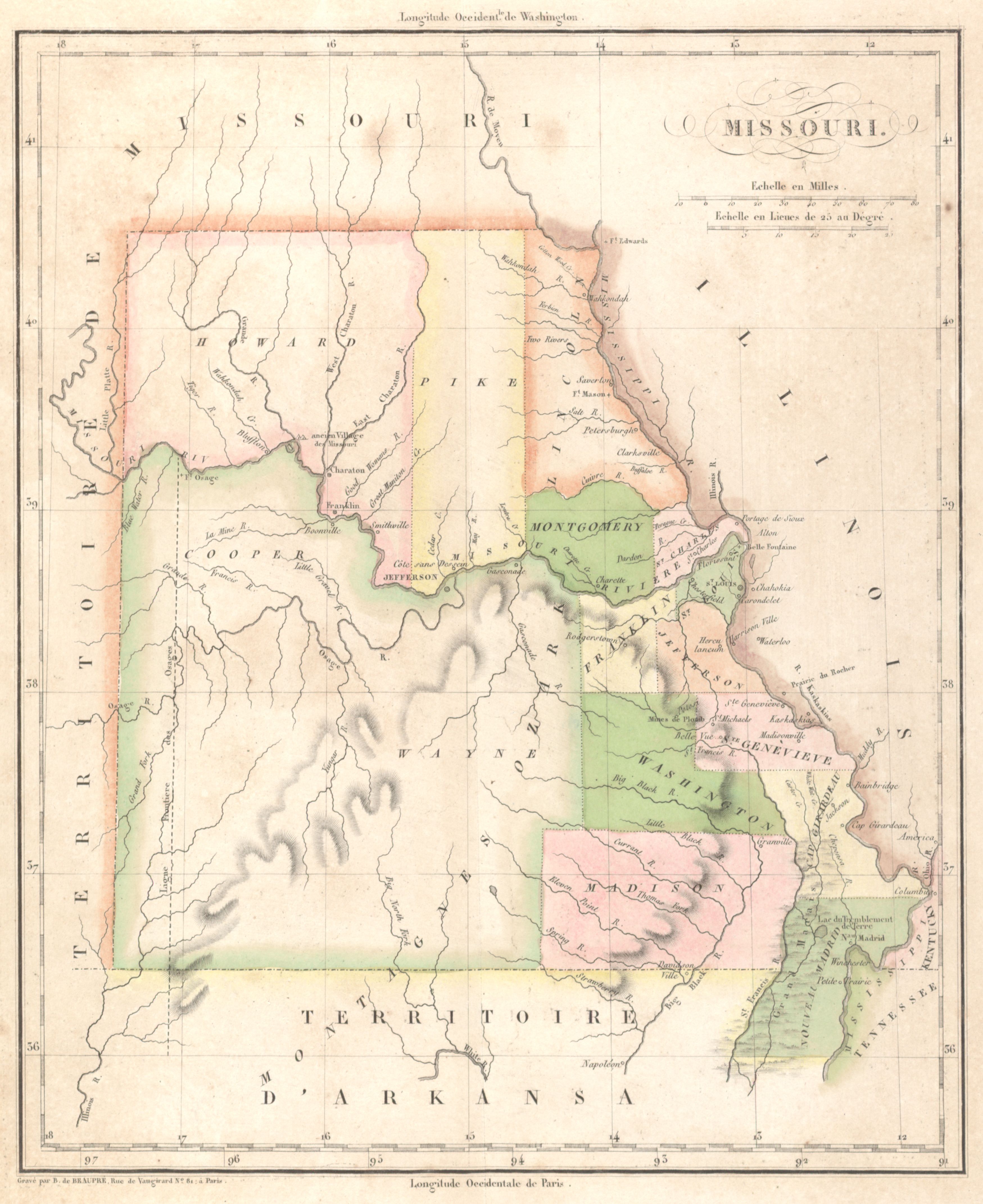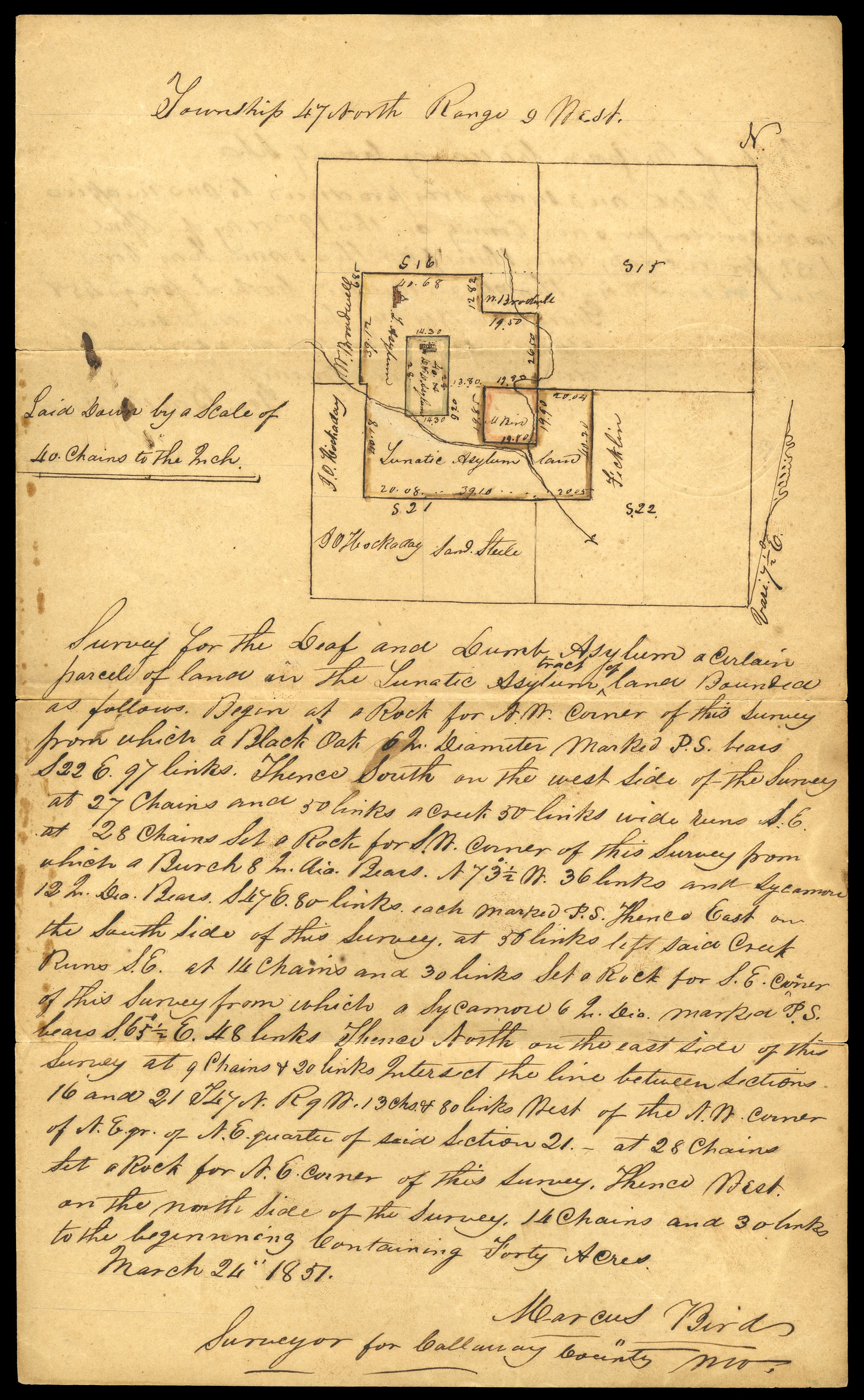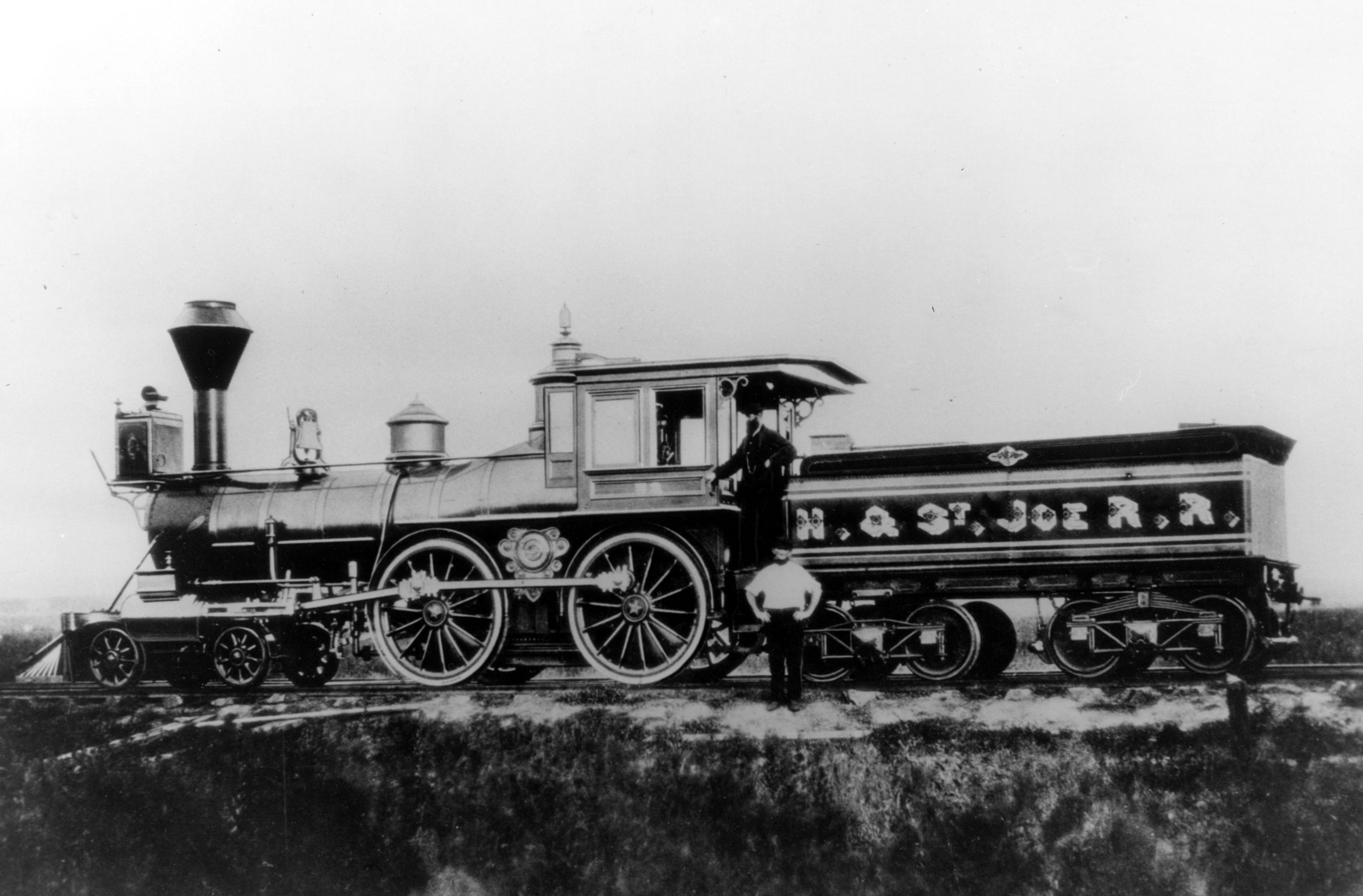| 1821 |
President James Monroe signed a proclamation on August 10, 1821 for Missouri to become the 24th state. The state capitol was located in St. Charles until a permanent location was designated. |
| 1821 |
The Santa Fe Trail was widened to a wagon road for trade by William Becknell in September 1821 allowing it to serve as a commercial highway. |

Map of the Missouri Territory, ca. 1820 |
| 1821 |
Governor Alexander McNair signed the bill designating the site of the City of Jefferson as the seat of government on December 31, 1821. |
| 1824 |
In the slave freedom suit Winny v. Whitesides, the Missouri Supreme Court established the judicial precedent of "once free, always free" on December 30, 1824 to determine the outcome of freedom suits, retaining prior territorial legislation. |
| 1825 |
Massey Iron Works, the first commercially viable iron works in the United States west of the Mississippi, located near modern-day Meramec State Park, was established and produced iron from 1827 to 1891. The Iron Works used the flow of water from a local spring and charcoal made from local forests to power kilns to process high-grade iron ore. |
| 1826 |
Missouri State Government permanently moved to Jefferson City on October 1, 1826. |
| 1829 |
Between 1830 and 1840, more than 38,000 Germans settled in the area known as the “Missouri Rhineland” from St. Louis to Hermann with more following in later decades. Much of this can be attributed to Henry Duden’s 1829 self-published a promotional pamphlet touting the abundant lands in Missouri upon his return to Germany. |
| 1833 |
Dr. John Polk Campbell donated land in 1833 for the county seat of Greene County. The city of Springfield was incorporated in 1838. |
| 1835 |
On March 19, 1835, the Missouri General Assembly passed “An Act to regulate the sale of the sixteenth sections, and to provide for organizing, regulating and perpetuating common schools.” The act outlined funding for public schools in Missouri, established a Board of Commissioners (the precursor to the State Board of Education), and provided for at least six months of education each term. |
| 1836 |
The Missouri State Penitentiary received its first prisoner - Wilson Eidson of Greene County who was convicted of Grand Larceny - on March 8, 1836. The Penitentiary was the first to open west of the Mississippi River. |
| 1837 |
President Martin Van Buren issued a proclamation on March 28, 1837 completing the annexation of the Platte Purchase area to Missouri, adding the northwestern portion of the state. Missouri was not allowed to expand the state due to the Missouri Compromise, however the General Assembly petitioned Congress to acquire the area. This land was acquired through the Treaty of Chicago (1835) with the Potawatomi and a Treaty with the Iowa and Sauk and Fox (1836). |
| 1838 |
The Cherokee passed through Missouri on the “Trail of Tears” as part of the forced Indian removal in 1838. Coming from parts of North Carolina and Georgia, numerous groups of Cherokee trekked through the mountains primarily between Jackson in Cape Girardeau County and Springfield along three routes in the southern part of the state before relocating to Indian Territory. |
| 1838 |
As a result of conflict between Mormons and other white settlers in the western part of the state, Gov. Lilburn Boggs issued an order on October 27, 1838 demanding “Mormons must be treated as enemies, and must be exterminated or driven from the state if necessary.” Gov. Christopher “Kit” Bond rescinded this order on June 25, 1976. |
| 1839 |
The Geyer Act, “An Act to provide for the institution and support of a State University and for the government of Colleges and Academies,” which created the foundation of Missouri’s public university system, was approved on February 9, 1839. |
| 1839 |
The Honey War, a bloodless territorial dispute over a 9.5 mile wide strip between the Iowa Territory and Missouri, erupted in 1839. Militias from both sides faced off in a stalemate after a conflict regarding taxes on three bee trees. The U.S. Supreme Court would eventually determine the matter in State of Missouri vs. State of Iowa on April 6, 1849. |
| 1841 |
The State University (now the University of Missouri), the first state university west of the Mississippi River, opened on April 14, 1841. |
| 1842 |
The first organized Oregon Trail wagon train left from Elm Grove, Missouri on May 16, 1842. |
| 1845 |
The town of St. Joseph was incorporated on February 26, 1845. Joseph Robidoux established a trading post known as Blacksnake Hills in that location in 1826. |
| 1845 |
The second Missouri Constitutional Convention began meeting in Jefferson City on November 17, 1845. The proposed Constitution changed terms of office for the judiciary and the representation ratio for the Missouri House of Representatives and Senate, but was rejected by voters in August 1846. |
| 1846 |
Dred and Harriet Scott, an enslaved couple in St. Louis, sued for their freedom in the St. Louis Circuit Court on April 6, 1846, under Missouri’s “once free always free” statutes. The suit was allowed based on their owner moving them to the free territory of Wisconsin before returning them to Missouri. |
| 1847 |
State Hospital No. 1 was established in Fulton on February 16, 1847 as a hospital for care and treatment of the “insane” and began receiving patients in 1851. |
| 1847 |
The Missouri General Assembly passed “An Act respecting slaves, free negroes, and mulattos” prohibiting the education of Black people, free or enslaved, on February 16, 1847. This act also included that no other free persons of color could immigrate into the state, contradicting the second Missouri Compromise which stated the Missouri constitution should "never be construed to authorize the passage of any law" impairing the privileges and immunities of any U.S. citizen. |
| 1847 |
After Congress declared war on Mexico, over 1,350 Missourians volunteered. Alexander Doniphan, Colonel of the 1st Regiment Missouri Mounted Volunteers, led the troops to play a major role in several victories in northern Mexico, most notably the Battle of Sacramento River on February 28, 1847. |
| 1847 |
St. Louis was connected to the East Coast by telegraph on December 20, 1847. |
| 1849 |
With the discovery of gold in California in 1849, the Missouri towns of St. Louis, Independence, St. Joseph, and Westport Landing (in modern Kansas City) and became primary points of departure for emigrants bound for California, establishing Missouri as the "Gateway to the West." |

RG5.10, Deeds and Easements, Deaf and Dumb Asylum, 1851
|
| 1849 |
The second, and most serious, cholera epidemic struck Missouri in the spring and summer of 1849 and over 4,000 people died in St. Louis alone. That same year on May 17, 1849, a devastating fire destroyed most of downtown St. Louis and numerous steamboats along the riverfront. |
| 1850 |
The Town of Kansas (now Kansas City) was incorporated on February 4, 1850 after the Kansas Town Company, a group of 14 investors, settled the area. |
| 1851 |
The Missouri School for the Deaf was established on February 28, 1851 and opened on November 5 later that year in Fulton. |
| 1851 |
Groundbreaking ceremonies for the construction of the Pacific Railroad, the first railroad in Missouri, were held in St. Louis on July 4, 1851. |
| 1854 |
President Franklin Pierce signed the Kansas-Nebraska Act on May 30, 1854, allowing "popular sovereignty" in determining if a territory would be a slave state or a free state. This act set the stage for the violent Missouri-Kansas Border War where the Missouri "Border Ruffians" and the Kansas "Jayhawkers" transformed a frontier fight over slavery into a national issue. |
| 1855 |
The Missouri School for the Blind in St. Louis, previously a private endeavor, became a state institution on February 24, 1855. In 1860, the Missouri School of the Blind became the first school in the United States to adopt the use of Braille, an alphabet consisting of raised dots. |
| 1855 |
On November 1, 1855, in the first major bridge collapse in American history, a train pulled by the locomotive O’Sullivan plummeted into the Gasconade River killing 30 and wounding hundreds, many of which were prominent Missourians. |
| 1857 |
U.S. Chief Justice Roger B. Taney handed down the Dred Scott decision March 6, 1857. The case, Dred Scott v. Sanford, which originated in St. Louis, intensified the controversy regarding the expansion of slavery. Taney concluded that Scott lacked standing in court because he lacked U.S. citizenship. In Taney's Opinion, enslaved people as well as free persons of color, would never be able to become U.S. citizens and therefore Scott had no standing to sue in a court of law. Taney also took the opportunity to argue that each state had the right to determine the status of enslaved people, and Congress had exceeded its powers in forbidding slavery in certain areas of the Louisiana Purchase; therefore, the Missouri Compromise was unconstitutional. |
| 1858 |
The Butterfield Overland Mail Company began using stagecoaches to transport mail and passengers on September 18, 1858. One of the routes began by train in St. Louis, switched to stagecoach in Tipton, before heading south to Fort Smith, Arkansas and then west to San Francisco. |
| 1859 |
The Hannibal and St. Joseph Railroad was completed February 13, 1859, making it the first railroad to cross Missouri. |

RG5, Publications-Non-Portrait Collection, Hannibal and Joseph Railroad Car
|
| 1860 |
E. Anheuser & Co. was established in St. Louis in 1860. Eberhard Anheuser had bought a struggling brewing company in 1852 and grew the business. Son-in-law Adolphus Busch would later join as company secretary and then becoming an administrator. E. Anheuser & Co. was renamed Anheuser-Busch in 1879 and was the first American brewery to use pasteurization, mechanical refrigeration, and refrigerated railroad cars to keep beer fresh. |
| 1860 |
The short-lived Pony Express started its first run from St. Joseph to Sacramento, California on April 3, 1860. The last run was on October 24, 1861. |